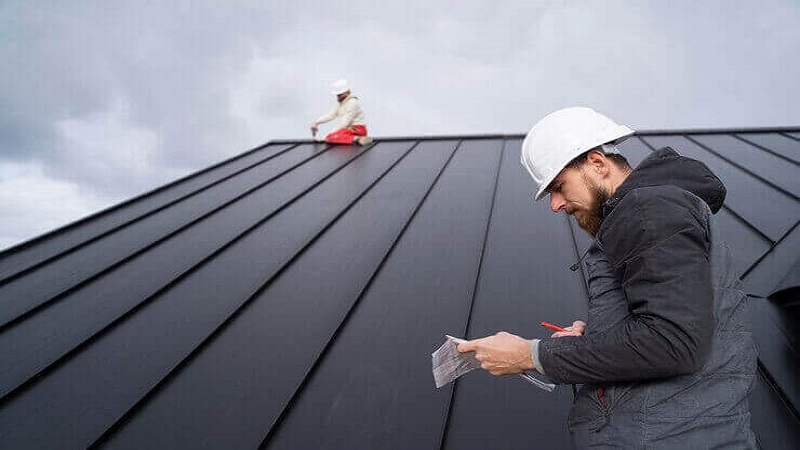Wisconsin is known for its harsh winters, hot summers, and frequent storms, which can present significant challenges for homeowners. When it comes to selecting the best roofing material, it’s crucial to consider the state’s unique climate conditions. From heavy snowfalls and ice dams to intense UV exposure during the summer, Wisconsin’s weather demands durable, energy-efficient, and weather-resistant roofing solutions. This article explores the best roofing materials suited for homes in Wisconsin, considering factors like longevity, cost, maintenance, and aesthetic appeal.
Asphalt Shingles: The Most Popular and Cost-Effective Choice
Asphalt shingles are the most common roofing material in Wisconsin, and for good reason. They offer a balance of affordability, durability, and ease of installation. These shingles are made of a fiberglass base coated with asphalt and mineral granules, which provide protection against the elements.
Advantages:
- Cost-Effective: Asphalt shingles are relatively inexpensive, making them a popular choice for budget-conscious homeowners.
- Versatility: Available in a wide range of colors and styles, asphalt shingles can mimic the appearance of more expensive materials like wood or slate.
- Ease of Installation: Asphalt shingles are easy to install, reducing labor costs and time.
Disadvantages:
- Lifespan: While affordable, asphalt shingles typically last around 15-30 years, which is shorter compared to other materials.
- Weather Vulnerability: In Wisconsin’s extreme weather, asphalt shingles can be prone to damage from high winds, hail, and ice dams.
Metal Roofing: A Durable and Energy-Efficient Option
Metal roofing is becoming increasingly popular in Wisconsin due to its exceptional durability and energy efficiency. Made from materials like steel, aluminum, or copper, metal roofs are designed to withstand severe weather conditions.
Advantages:
- Longevity: Metal roofs can last 40-70 years, significantly longer than asphalt shingles.
- Weather Resistance: Metal roofs are highly resistant to wind, hail, and heavy snow, making them ideal for Wisconsin’s climate.
- Energy Efficiency: Reflective coatings on metal roofs can reduce cooling costs in the summer by reflecting sunlight away from the home.
- Environmental Impact: Metal roofing is often made from recycled materials and is fully recyclable at the end of its life.
Disadvantages:
- Cost: The initial cost of metal roofing is higher than asphalt shingles, which may deter some homeowners.
- Noise: Without proper insulation, metal roofs can be noisy during rain or hailstorms.
- Aesthetic Limitations: While metal roofing is available in various colors and styles, it may not suit the architectural style of all homes.
Slate Roofing: The Premium, Long-Lasting Choice
Slate roofing is known for its beauty, longevity, and high-end appeal. Made from natural stone, slate tiles offer unparalleled durability and can last over a century with proper maintenance.
Advantages:
- Longevity: Slate roofs can last 100 years or more, making them a lifetime investment for homeowners.
- Aesthetic Appeal: The natural beauty of slate adds an elegant and timeless look to any home.
- Weather Resistance: Slate is highly resistant to fire, wind, and water, making it a robust choice for Wisconsin’s weather extremes.
Disadvantages:
- Cost: Slate roofing is one of the most expensive options, both in terms of materials and installation.
- Weight: Slate is very heavy, requiring a reinforced roof structure to support its weight.
- Installation: Installing a slate roof requires specialized skills, which can drive up labor costs.
Wood Shingles and Shakes: Aesthetic Appeal with Environmental Benefits
Wood shingles and shakes provide a natural, rustic appearance that complements many of Wisconsin’s traditional homes. Made from cedar, redwood, or pine, wood roofing offers a unique charm and is environmentally friendly.
Advantages:
- Aesthetic Value: Wood shingles and shakes add a natural, warm appearance to homes, blending well with the environment.
- Insulation: Wood is a natural insulator, helping to keep homes warm in the winter and cool in the summer.
- Sustainability: Wood roofing is biodegradable and often sourced from sustainable forests.
Disadvantages:
- Maintenance: Wood roofing requires regular maintenance, including treatments for fire resistance, rot, and insect infestation.
- Longevity: Wood shingles and shakes typically last 20-30 years, which is shorter than other premium materials.
- Vulnerability: In Wisconsin’s wet and snowy climate, wood roofing can be susceptible to mold, mildew, and water damage.
Tile Roofing: A Durable Option with a Distinctive Look
Tile roofing, typically made from clay or concrete, is known for its durability and distinctive appearance. While less common in Wisconsin, it can be an excellent choice for homeowners seeking a unique and long-lasting roof.
Advantages:
- Longevity: Tile roofs can last 50 years or more, offering excellent long-term value.
- Weather Resistance: Tile is resistant to fire, wind, and severe weather, making it a strong choice for Wisconsin’s climate.
- Aesthetic Appeal: Tile roofs offer a distinctive, Mediterranean-inspired look that can enhance a home’s curb appeal.
Disadvantages:
- Cost: Like slate, tile roofing is expensive, both in materials and installation.
- Weight: Tile is very heavy, requiring additional structural support.
- Climate Suitability: Tile roofs are more common in warmer climates and may not be as efficient in Wisconsin’s cold winters.
Synthetic Roofing: The Modern, Versatile Option
Synthetic roofing materials, such as synthetic slate or composite shingles, are designed to mimic the appearance of natural materials like slate, wood, or tile, while offering enhanced durability and lower costs.
Advantages:
- Versatility: Synthetic roofing can replicate the look of high-end materials at a fraction of the cost.
- Durability: These materials are engineered to withstand extreme weather conditions, including Wisconsin’s harsh winters.
- Lightweight: Synthetic roofing is lighter than natural materials, reducing the need for additional structural support.
- Environmental Impact: Many synthetic roofing products are made from recycled materials, contributing to sustainability.
Disadvantages:
- Longevity: While durable, synthetic roofing may not last as long as natural materials like slate or metal.
- Cost: Although cheaper than natural materials, synthetic roofing is more expensive than asphalt shingles.
- Aesthetic Perception: Some homeowners may prefer the authenticity of natural materials over synthetic options.
Green Roofing: An Eco-Friendly and Energy-Efficient Choice
Green roofing, also known as living roofs, involves the installation of vegetation on the roof surface. This type of roofing is gaining popularity for its environmental benefits and energy efficiency.
Advantages:
- Environmental Benefits: Green roofs reduce stormwater runoff, improve air quality, and provide habitats for wildlife.
- Energy Efficiency: The vegetation on a green roof provides natural insulation, reducing heating and cooling costs.
- Aesthetic Appeal: Green roofs can transform a home’s appearance, creating a unique and natural aesthetic.
Disadvantages:
- Cost: Green roofing can be expensive to install and maintain, especially in Wisconsin’s climate.
- Maintenance: Green roofs require regular maintenance, including watering, weeding, and replacement of plants.
- Structural Requirements: Green roofs are heavy and require a strong, reinforced roof structure to support the weight of soil and vegetation.
Conclusion:
Selecting the best roofing material for a home in Wisconsin involves careful consideration of several factors, including the local climate, budget, and aesthetic preferences. While asphalt shingles remain the most popular and cost-effective option, materials like metal, slate, and synthetic roofing offer greater durability and weather resistance. For homeowners seeking eco-friendly solutions, green roofing provides environmental benefits and energy efficiency, though it comes with higher costs and maintenance requirements.

